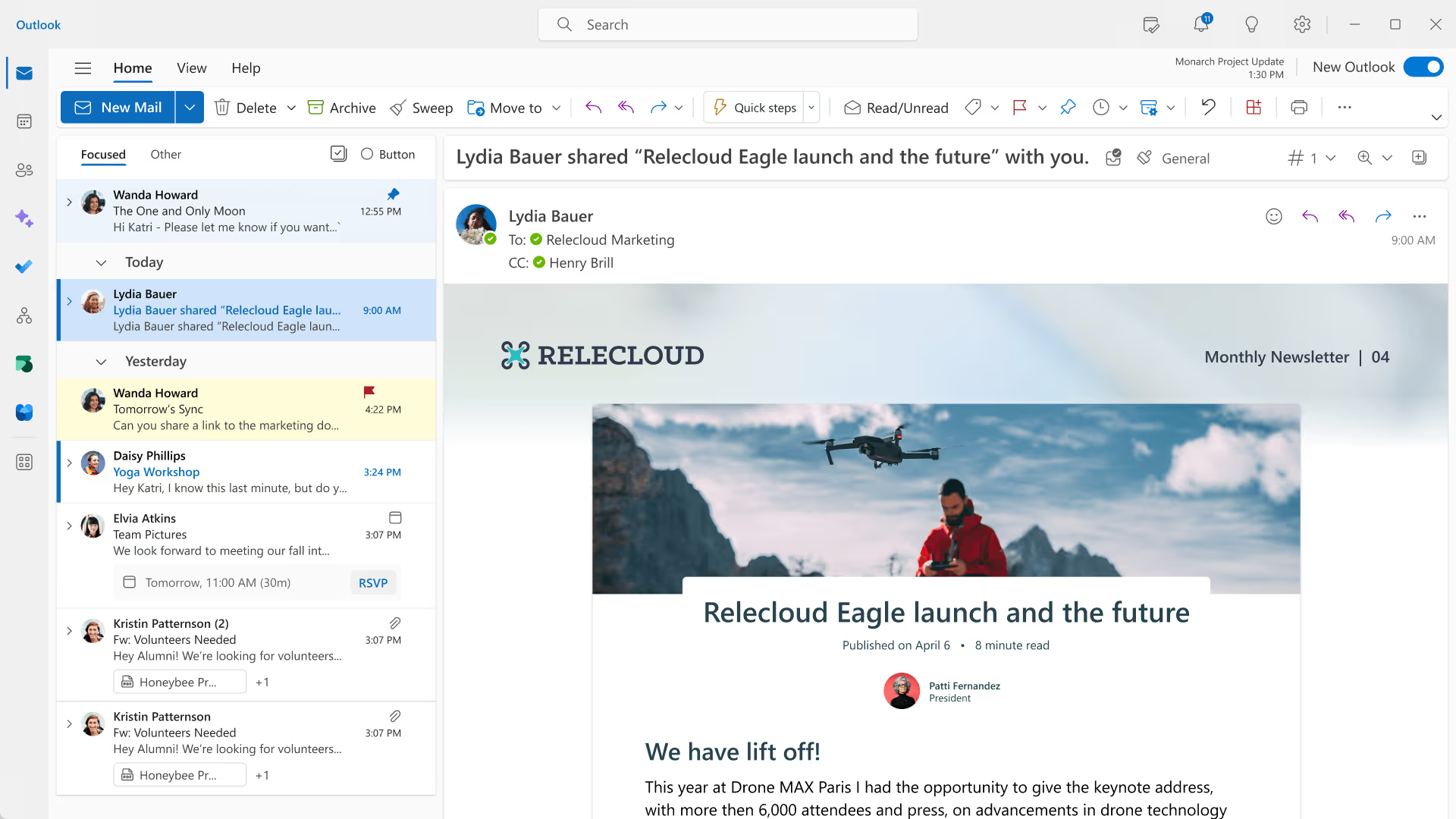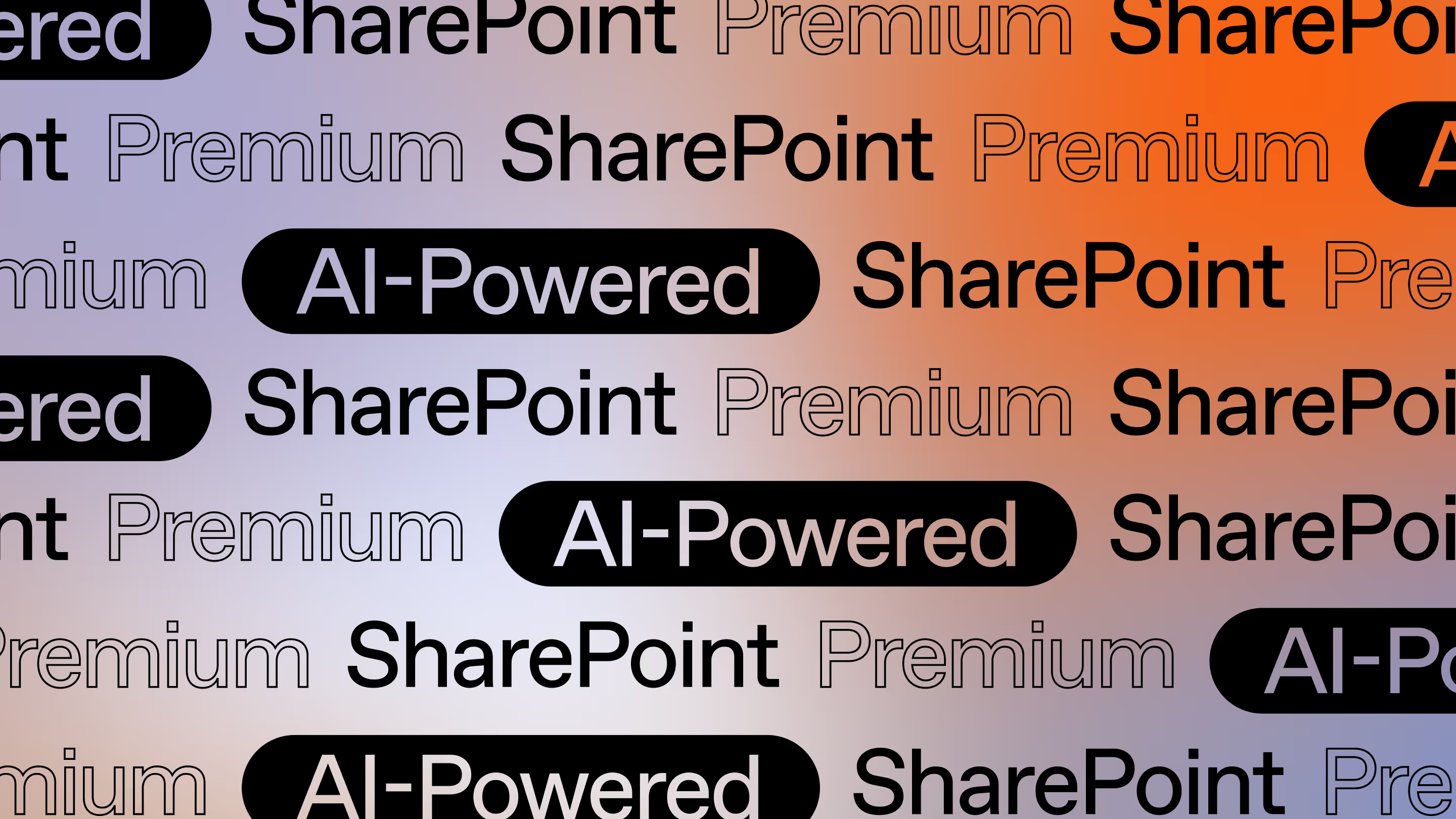SharePoint's latest innovations: Copilot, a brand new look, and more

Table of contents
Microsoft announced its latest updates to SharePoint, including enabling users to build sites more easily with AI. We explore the new features and what they mean for you.
You know SharePoint as Microsoft 365’s content platform, a flexible service over which thousands of organizations worldwide build knowledge bases and news centers for their employees—namely, intranets. SharePoint is also the backbone of other Microsoft 365 apps, such as Teams, for which it serves as a content repository. The result is ever-increasing adoption: today, SharePoint stores over 200 petabytes of documents, lists, pages, and videos.
Microsoft, however, just announced a set of innovations that are bound to transform the SharePoint experience. On the one hand, the company is tapping into the much-talked-about promise of AI to help site authors start creating content. On the other, it’s providing SharePoint with new looks and integrations that aim to entice users to engage within the platform more than ever.
Microsoft expects these changes to redefine the intranet experience, empowering people to easily create SharePoint content that’s visual and engaging. This article will dive into these innovations and elaborate on what IT teams and end users can expect.
What’s new in SharePoint
The announcements made by Microsoft about SharePoint cover four basic themes:
- Simpler authoring—With Copilot in SharePoint, site authors will be able to create SharePoint pages faster and easier and collaborate with others in real-time
- Compelling content—SharePoint underwent a major visual revamp, allowing authors to embrace images and video and create beautiful web designs consistent with their brand
- Deeper engagement—New integrations into email, Teams, and Viva enable site owners and authors to rely on SharePoint to reach audiences exactly where they work
- Flexible platform—The existing solutions for developers will continue to work even as the user experience is updated so that SharePoint sites can be tailored to specific needs
Simpler authoring with Copilot
Anyone can have a hard time creating and managing SharePoint sites. Getting started with writing can be difficult even for content specialists, let alone for others not used to creating and editing text or planning strategies to build engaging, informative web pages.
To help users overcome this, Microsoft is introducing Copilot in SharePoint—one of the most significant innovations in the tool since its launch more than 20 years ago. Copilot is essentially a combination of Large Language Models (LLMs) such as OpenAI’s GPT-4 (which powers the immensely popular AI tool ChatGPT) and the user’s business data stored in Microsoft Graph to generate relevant, compelling web content—in this case, SharePoint sites and pages.
https://www.youtube.com/watch?v=E5g20qmeKpg
All users need to do is go to the SharePoint start and type a brief prompt, like "Create an employee onboarding site for Product Managers based on this PowerPoint presentation." After this request, Copilot in SharePoint will create a starter site, bringing in information retrieved from across the organization and, in this example, from the presentation indicated by the author.

Before SharePoint, Copilot was already available in other Microsoft 365 apps like Word, Excel, Outlook, and Teams. For SharePoint users, it promises a new experience: by kickstarting content and spending less time configuring sites, people can expect to unlock productivity while maintaining total data security and privacy. GitHub data shows that 88% of developers who use GitHub Copilot say they’re more productive, 74% say they can focus on more satisfying work, and 77% say it helps them spend less time searching for information.
Apart from Copilot, SharePoint now has a new page coauthoring capability so editors can come together into the same page canvas and create their content in real time. This feature is based on the Microsoft Fluid framework, the same technology that powers Microsoft Loop.

Besides creating new pages, Copilot helps authors turn their existing content into SharePoint sites that draw people in and boost interaction. For example, it can help them rewrite key text passages straight on the page so they hit the right tone to engage readers. Or, if something doesn’t look quite right, Copilot works alongside the user to turn the existing document or presentation into a page that leverages SharePoint’s web design visuals the best way possible—like iterating on navigation and look-and-feel settings, functioning as an actual web design partner.
A new look for SharePoint sites and pages
Speaking of visuals, Microsoft also announced bolder, more sophisticated design elements for users to create engaging digital experiences in their SharePoint sites and pages. This new look is to be made available into the product seamlessly—with no "classic to modern" upgrade.
Those improvements focus on the many different aspects of web design, like branding, theming, typography, fonts, layout, images, video, animations, and motion. SharePoint’s new visual elements are built upon the Microsoft Fluent Design System and were designed so that authors can create sites and pages that feel natural alongside other Microsoft 365 experiences.

In that sense, SharePoint now has a Brand Center to make it even more convenient for users to build consistent sites. It enables authors to specify fonts, colors, logos, and other design elements and use them across SharePoint, enforcing guardrails so that all sites and pages are under the same branding guidelines. With the Brand Center, site owners can reflect their organization’s identity with full authenticity and help people feel more connected to it.

More image and video capabilities in SharePoint
One of the ideas behind SharePoint’s revamped visuals is enabling authors to harness the eye-catching nature of images and videos. And to realize that promise, new features allow users to easily edit and integrate multimedia into their content on the page. Here they are:
- New image editor with advanced capabilities like shape cropping, color adjustments, adding filters, and overlaying text
- Updated Stream web part for streaming all types of media inside the pages, supporting single and multiple videos with folders and playlists
- Create SharePoint video pages directly from Stream, starting right from the video itself
- Renewed video page templates to better highlight relevant video content, like town hall meeting recordings
- A new content panel allows users to quickly browse and embed content or redesign their SharePoint pages with automatic layout suggestions

Driving SharePoint engagement across Microsoft 365 apps
So now, people can create content in SharePoint as easily as ever before, exploring images, videos, and bold visual elements to build enticing new digital experiences for their organizations. The question is: what good would it be if people didn’t discover what’s been created?
That’s why SharePoint is now going through a new integration with other Microsoft 365 apps so that content reaches the right audiences in the services they use daily, delivering the same experience and engaging people more. Let’s see how it goes for each new app integration:
- Email—Now, users can preview and send full SharePoint news posts as emails to readers, with the option of using six templates to get started. Also, with the unified webpage analytics, they can see the total page reads across Outlook and SharePoint.

- Teams—When a SharePoint page is connected to a Teams channel, users see the content right in the hub for collaborating, with the very same experience in the two apps. This was made simpler by enabling page editing inside Teams and by ensuring channel templates can include SharePoint pages as channel tabs.

- Viva—Users can leverage Viva—Microsoft 365’s employee experience platform—to make their content more discoverable, like sharing news in the Viva Connections feed and the Viva Engage communities and storylines—right in from SharePoint

A more flexible SharePoint for easier customization
As much as those innovations make users more comfortable with creating sites and pages, many organizations rely on developers to ensure that SharePoint caters to their needs through customization. In fact, one out of every three pages in SharePoint includes an embedded part of a custom business process or application.
For that reason, developer models such as SharePoint Framework (for templating, UX, and plug-ins) and Microsoft Graph (for data access) are constantly maintained and improved. Here is some recent and upcoming news for SharePoint developers:
- SharePoint Framework 1.17 has been providing improvements to web part configurations, new capabilities for Viva Connections cards, and support for SharePoint Framework solutions in Outlook and the Microsoft 365 app
- Viva Connections cards now have their own product type in App Source: SharePoint Framework solutions containing cards will be automatically listed under Viva product type.
- The SharePoint Pages API will move from Beta to GA in May 2023
- Soon, developers will have more granular control of SharePoint data access by scoping application access to a specific site, list, or even single file
Want to learn more about SharePoint's latest innovations and what lies ahead for Microsoft 365 and its tools? Watch our fireside chat with Jeff Teper, President of Microsoft’s OneDrive, SharePoint, and Office product lines!
The pros and cons of the latest SharePoint innovations
These innovations look like a lot to process now, but one thing is crystal-clear from the start: they have the potential to totally transform the way users create and relate to SharePoint sites and pages. And, as in most things in life, these changes might come for good or bad.
First, the good news: making people comfortable with tools is always positive. Enabling employees to easily create engaging SharePoint sites and pages empowers them and inspires them to do things themselves because they see how other people consume this content and how effective this process is. So, they become more satisfied, they collaborate more, and adoption comes along, as does productivity. Digestible content makes people share, interact with it, and engage with the organization.
Now, the challenging part: users feeling more at ease with SharePoint could create duplicate sites and pages or ones that aren’t aligned either with the brand, with daily work, or with the company’s mission and purpose. Without visibility on the tenant, governance policies, or guardrails in place, this sudden increase in site volume and content creation will generate sprawl—a ruthless productivity killer—for end users and IT alike.
We've elaborated on these pros and cons later in another article. For now, you might want to know that ShareGate is already set up to support these new SharePoint features and functionalities. And if you’re not a ShareGate user yet, check out how it can be the extra help your need to manage, secure, and future-proof your Microsoft 365 environment with ease.
According to Microsoft, its customers have been asking for an easier way to create SharePoint sites, and here it is! You can’t deny its immense potential for driving adoption and productivity. Now it’s time for IT to be ready for this new wave of collaboration and engagement and help turn this promise into a reality.
.jpg)


.svg)
.avif)
%20(1).avif)












.jpg)


.png)

